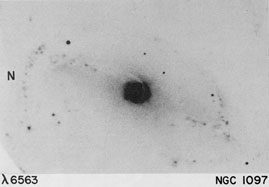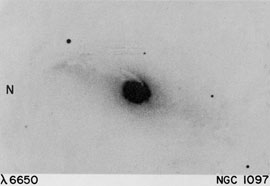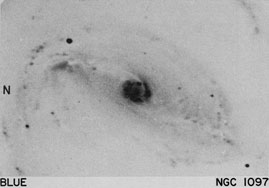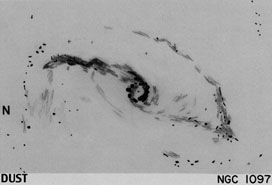


NGC 1097. - The HII regions of this galaxy clearly define a spiral pattern; more so than does the dust in the outer arms. The bright inner ring of HII regions, resembling NGC 4314, was described by Sersic (1958) as a chain of condensations forming a single spiral arm. This structure could also be interpreted as being aligned along the outer edge of two dust lanes which wind out from the nucleus to form the lanes along the bar. Along the northwest dust lane there are at least three relatively bright HII regions which are embedded in the dust and are very much fainter on the blue photograph. This galaxy also has remarkable symmetry, even to the extent of "matching" arcs of HII regions spiraling out to 90° from the ends of the bar.
A number of HII regions lie along the outer south-western and northeastern arcs and are beyond the cropped pictures of this atlas. These HII regions coincide with the brighter blue regions seen on the Hubble atlas photograph of the galaxy (Sandage 1961). There are also two or three HII regions located between the inner and outer spiral arms to the northwest of the nucleus. These lie in the "flare" reported by Sersic.
The conspicuousness of the dust lane on the north-western half of
the bar suggests that this is the near side of the galaxy. The
Burbidges (1960)
report that the NW part of the inner HII regions is
approaching (v  1100 km
s-1) compared with the SE part
(v
1100 km
s-1) compared with the SE part
(v  1500 km
s-1). If the outer arms follow the same pattern, the
interpretation is
consistent with a model with trailing arms. Accepting this sense of
orientation, we see that the primary dust lanes and the associated HII
regions along the bar lead the amorphous luminous bar.
1500 km
s-1). If the outer arms follow the same pattern, the
interpretation is
consistent with a model with trailing arms. Accepting this sense of
orientation, we see that the primary dust lanes and the associated HII
regions along the bar lead the amorphous luminous bar.

| 
|

| 
|